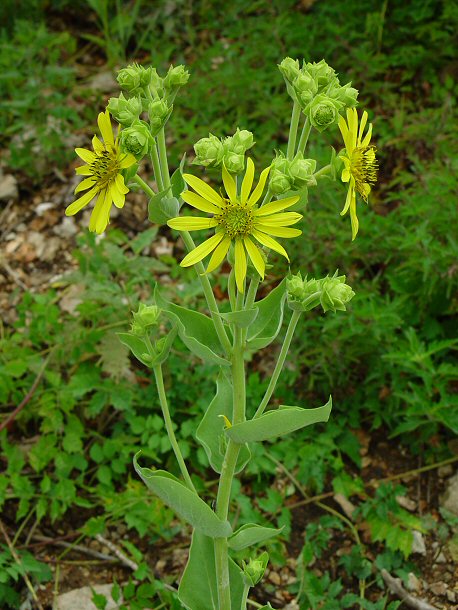Silphium integrifolium Michx.
Rosinweed

Native
CC = 4
CW = 5
MOC = 80
© SRTurner
Silphium integrifolium Michx.Rosinweed | |
 |
Native CC = 4 CW = 5 MOC = 80 |
© SRTurner |
|
Family - Asteraceae/Heliantheae Habit - Perennial forb with short, stout rhizomes. Stems - Erect, 40-200 cm long, single or multiple from the base, circular in cross-section (often finely many-angled), glabrous or moderately to densely pubescent (variously velvety to roughened) with relatively short (mostly 0.1-0.5 mm), slender to stout hairs, if glabrous then sometimes strongly glaucous.
Leaves - Opposite, simple, decussate, sessile. Blades usually relatively thick and sometimes somewhat leathery, the upper surface glabrous or sparsely to strongly roughened, the undersurface glabrous or moderately to densely roughened or hairy with short, sometimes pustular-based hairs, when glabrous both surfaces sometimes glaucous. Basal and lowermost stem leaves absent or withered at flowering, with a winged, more or less petiolar base, the bases slightly expanded and somewhat clasping or wrapped around the stem, the blade 7-15 cm long, ovate to elliptic-ovate or narrowly ovate, unlobed, tapered to a usually sharply pointed tip, tapered at the base, the margins entire or finely to occasionally coarsely toothed and usually with minute, more or less appressed hairs. Stem leaves somewhat reduced toward the tip of the stem, opposite (rarely alternate or in whorls of 3), 3-17 cm long, sessile, lanceolate to ovate, broadly ovate, or somewhat heart-shaped, angled to tapered or more commonly rounded to shallowly cordate at the base, sometimes clasping the stem, angled or tapered to a sharply pointed tip. Veins around the base of the blade impressed adaxially, expressed abaxially.
Inflorescences - Loose, open clusters or panicles, rarely of solitary heads, the heads long-stalked to shortstalked or nearly sessile. Inflorescence divisions subtended by a pair of reduced foliaceous bracts. Heads - Involucral bracts 25-38, 10-22 mm long, elliptic to ovate, spreading at the sharply pointed tip, the surfaces glabrous or moderately to densely short-hairy, sometimes also with stalked and/or sessile glands, the margins glabrous or more commonly with short, ascending to spreading hairs. Receptacle 1.5-2.5 cm in diameter.
Florets - Ray florets usually 20-35, fertile, the corolla yellow, 20-50 mm long. Disc florets numerous, staminate, the corolla yellow, 4.5-5.5 mm long, slightly shorter than or extending slightly beyond the tips of the chaffy bracts.
Fruits - Achenes 8-12 mm long, the surfaces glabrous or inconspicuously but densely hairy, the angles with relatively broad, lighter wings, each wing rounded to somewhat angled at the tip, the fruit usually with a narrowly U-shaped apical notch. Flowering - July - September. Habitat - Upland prairies, loess hill prairies, forest openings, savannas, bluffs, glades, streambanks, pastures, crop field margins, ditches, railroads, and roadsides. Origin - Native to the U.S. Lookalikes - Numerous other yellow composites, notably sunflowers (genus Helianthus). Other info. - This robust species can be found throughout the state. Missouri lies approximately at the center of the plant's wider distribution, which comprises a roughly circular patch extending from Louisiana to Wisconsin and from Kansas to Virginia. The leaflike, rounded involucral bracts and flowering heads with only the ray florets fertile (having divided styles) are strong clues to the identity. Both of these characters serve as unambiguous differentiation from sunflowers. Photographs taken off Hwy 60, Shannon County, MO., 7-19-03 (DETenaglia); also at Don Robinson State Park, Jefferson County, MO, 8-10-2024 (SRTurner). |